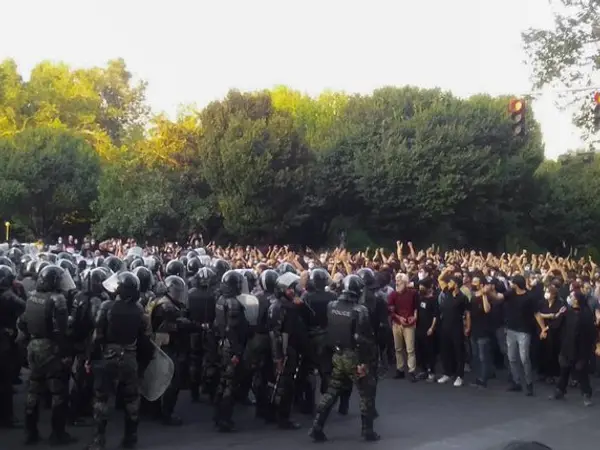Iranian activists and university professors have called for nationwide rallies on Saturday, October 8, as street protests have become sporadic in recent days.
Small and isolated flashmob protests continued Wednesday evening in several places as well as rooftop chanting and car horn honking. Some people say this is a sign the regime’s repressive methods are working. Nevertheless, others have urged Iranians to rally and protest in city squares across the country Saturday to demonstrate the might of the movement which they say now is the prelude to a revolution to overthrow the system rather than merely protesting its repressive policies.
In a statement Thursday, professors at the prestigious Sharif University of Technology in Tehran also urged all students and professors to rally in universities across the country Saturday in protest to the plainclothes security forces’ brutal attack on their university’s students October 2.
The European Parliament Thursday condemned the death of Mahsa Amini, the young girl whose death in custody sparked the recent protests in Iran, and asked for EU sanctions against her killers and those involved in quashing the ensuing street protests while the United States imposed sanctions on seven Iranian officials over the shutdown of internet access and the crackdown on peaceful protesters.
Authorities have arrested dozens of students and student activists protesting peacefully inside their university campuses, where the law bans armed forces from entering. Many students were arrested also at other locations including their homes.
Both calls to protest have been made only on social media as the extremely tight state censorship does not even allow media reporting of the protests, let alone publishing calls for demonstrations.
Students, mostly girls, in secondary schools, which only opened a few days ago for the new academic year, rebelled this week in many areas, refusing to attend classes, protesting inside their schools and chanting slogans on their way home. Students often burn the headscarves they are forced to always wear, in protest to hijab laws and the killing of Mahsa Amini who was arrested in Septamber for her ”improper hijab”..
Iranian authorities have clamped down on the protesters with such heavy methods that even some of their own supporters find it hard to digest.A regime insider, hardliner filmmaker Javad Moguei, has given a harrowing account of the brutality of the security forces in some Instagram posts. Moguei was shot with 14 plastic bullets and beaten up for objecting to security personnel attacking a young female protester on a Tehran street.
According to the Oslo-based Iran Human Rights Organization (IHR) at least 1,200, including 29 journalists, 20 rights activists, and 19 teachers, have been arrested since the protests began nearly three weeks ago. IHR said Tuesday that at least 154 protesters, including nine children have been killed by security forces during the recent protests.
Amnesty International said in a statement Thursday that Iranian security forces killed at least 66 people, including children, and 16 more in separate incidents in Zahedan, Sistan and Baluchistan province, amid an ongoing clampdown on ongoing protests in the province which brings the death toll in the province to 82. Local rights groups say the death toll has risen to 91.
Security forces fired live ammunition at Zahedan protesters, bystanders and worshippers after Friday prayers but claim the incident was provoked by armed separatist groups. Leading Baluchi Sunni cleric Molavi Abdolhamid who has refuted the authorities’ claims condemned the killing of protesters calling it a “massacre” Wednesday.
Authorities blame foreign ‘enemies’ for the unrest in the country. On Thursday the state media aired a trailer of purported confessions by two French citizens as proof that protests are being instigated and led from outside the country. France has strongly rejected the allegations and the airing of forced confessions by its citizens.
Authorities have imposed curfew-style internet shutdowns to break communication among protesters and prevent footage from leaking to social media, but some images continue to trickle out. They have also resorted again to orbital jamming of international satellite transmissions to stop the flow of news from foreign-based Persian televisions such as Iran International, BBC Persian, and Manoto TV.
